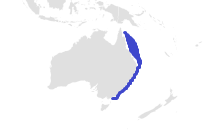Eastern angelshark facts for kids
Quick facts for kids Eastern angelshark |
|
|---|---|
| Conservation status | |
| Scientific classification | |
| Genus: |
Squatina
|
| Species: |
albipunctata
|
 |
|
| Range of the Eastern angelshark | |
The eastern angelshark (Squatina albipunctata) is a special type of angelshark. It belongs to the family called Squatinidae. These sharks are known for their flat bodies, which help them hide on the seafloor.
Contents
About the Eastern Angelshark
How Big Do They Get?
Eastern angelsharks are born quite small, about 30 centimeters (around 1 foot) long. This is their total length, from nose to tail.
When they become adults, male sharks are usually about 91 cm (3 feet) long. Females grow a bit larger, reaching about 107 cm (3.5 feet). The biggest eastern angelshark ever found was a female, measuring 130 cm (over 4 feet) long! Males can reach up to 110 cm (3.6 feet).
What Do They Look Like?
Eastern angelsharks have a unique look that helps them blend in. Their skin can be yellow-brown or even chocolate-brown. They have many small white spots with dark edges, arranged in a neat pattern. You might also see larger brownish blotches on their bodies.
They have a special white spot on their neck, but no eye-like spots (ocelli). Their fins that are not paired (like the dorsal fin) are light-colored and don't have spots.
Body Features
This shark has a very short snout, which is the front part of its head. The space between its eyes is curved inwards. It also has strong thorns around its eyes. These thorns help tell it apart from the Australian angelshark (Squatina australis).
Near its nose, it has special whiskers called nasal barbels. These have extended tips and frilly edges. The shark's spiracles, which are like small breathing holes, are close to its eyes. They are wider than the shark's eye length.
Unlike some other sharks, the eastern angelshark does not have a row of thorns down the middle of its back before its dorsal fin.
Where Do They Live?
Habitat and Location
You can find the eastern angelshark in the Pacific Ocean, specifically along the eastern coast of Australia. They live in the waters between Cairns in Queensland and Lakes Entrance in Victoria. This area stretches from about 17°S to 38°S latitude.
They prefer tropical waters. These sharks live on the outer part of the continental shelf and the upper slope of the ocean floor. This means they are found where the land gently slopes down into the deep ocean.
They are benthopelagic, which means they live near the bottom of the ocean but can also swim in the water above it. They usually hang out on sandy bottoms, typically between 37 and 415 meters (about 120 to 1,360 feet) deep. Sometimes, they can be found in shallower waters, up to 60 meters (about 200 feet) deep.
What Do They Eat?
Eastern angelsharks are likely predators. They probably eat a variety of sea creatures. Their diet includes bony fishes, which are most common fish. They also enjoy crustaceans, like crabs and shrimp. And they might snack on cephalopods, such as squid and octopuses.
How Do They Reproduce?
When eastern angelsharks have babies, they can have up to 20 pups in one litter. This means a single mother can give birth to many young sharks at once.
Are They in Danger?
Conservation Status
The eastern angelshark is listed as Vulnerable on the IUCN Red List. The IUCN Red List is a global list that tells us which animals and plants are at risk of disappearing. Being "Vulnerable" means that the eastern angelshark faces a high risk of becoming extinct in the wild.
This shark has a moderate to high chance of being affected by threats. Its population takes about 1.4 to 4.4 years to double in size. This is considered a medium rate of recovery.
Threat to Humans
Eastern angelsharks are considered harmless to humans. They are not known to attack people.
Images for kids
See also
 In Spanish: Squatina albipunctata para niños
In Spanish: Squatina albipunctata para niños



